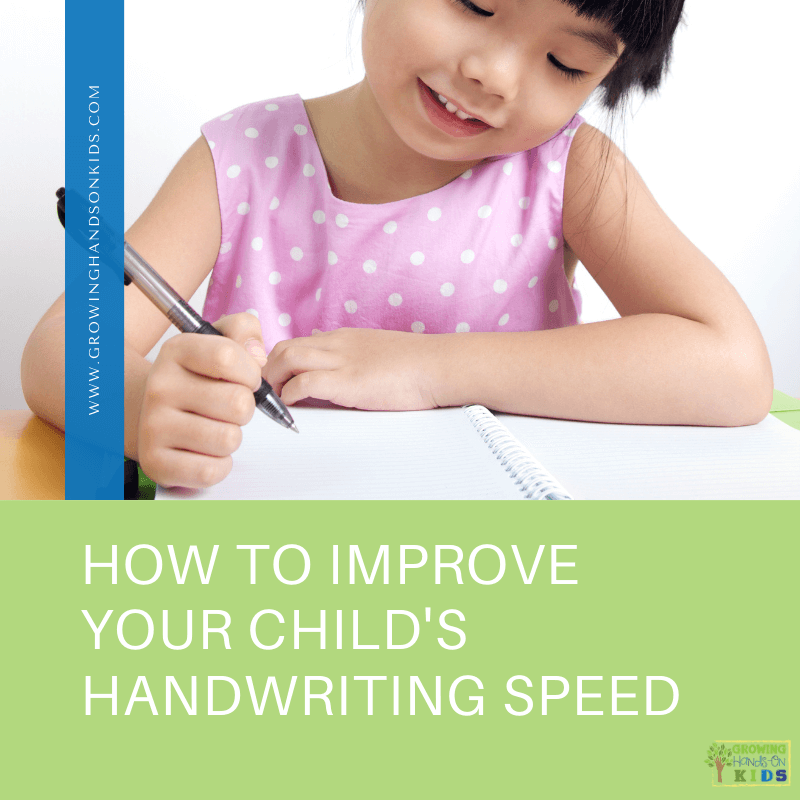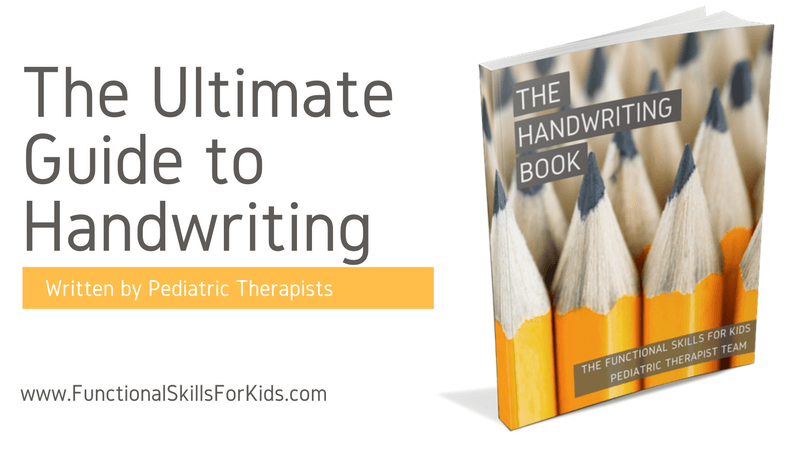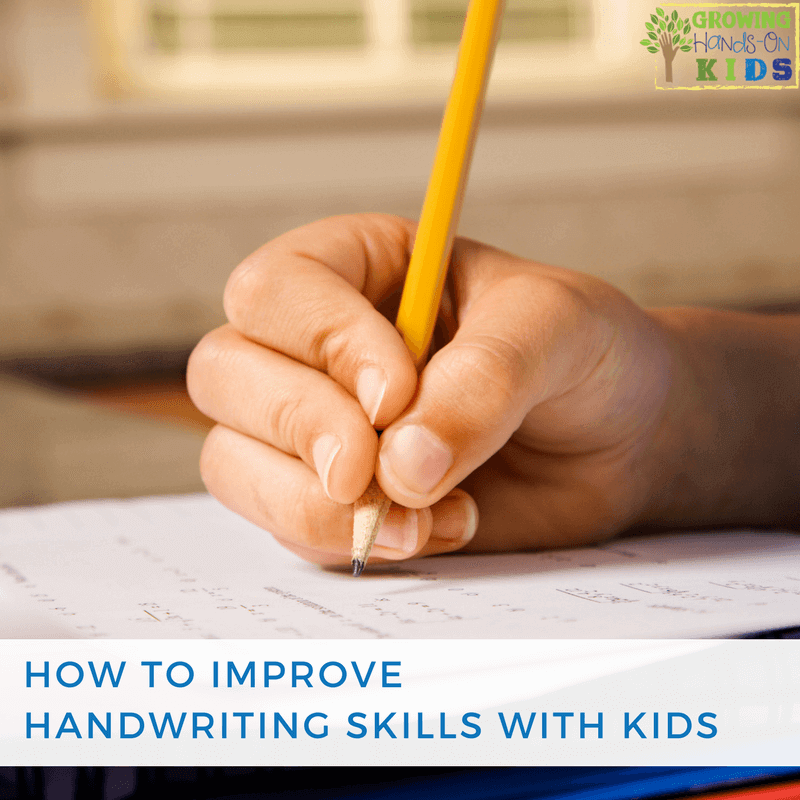How to Improve Your Child’s Handwriting Speed
Affiliate and Referral links are used below to promote products I love and recommend. I receive a commission on any purchases made through these links. Please see my disclosure policy for more details. As an Amazon Associate, I earn from qualifying purchases.
Does your child's handwriting speed affect their participation in writing assignments? Handwriting speed develops over time and there are some ways you can help improve it. Keep reading below to find out what typical writing speeds are by grade level and also some tips for improving handwriting speed.
Table of contents for handwriting speed
My goal with this post is to make understanding the development of handwriting speed easy to understand and explain. I've also included references for all my findings at the bottom of this post if you wish to dig into the nitty gritty of handwriting speed research.
Average handwriting speeds by age
When children start learning how to write, we expect them to not write as fast since they are still learning how to form letters correctly. As a child progresses in their handwriting development, their handwriting speed should increase. These are some handwriting speed norms that you can consider when addressing a child's handwriting speed difficulties.
It is important to note that these norms are for handwriting copying skills and that handwriting speed does decrease with composition. It does however give you a starting point to look at with handwriting speed since copying work is a skill that is often used in the classroom.
I will be using “wpm” to mean words per minute next to the averages.
Grade 1 – 4 to 5 wpm
Grade 2 – 6 to 7 wpm
Grade 3 – 7 to 10 wpm
Grade 4 – 8 to 13 wpm
Grade 5 – 10 to 15 wpm
Grade 6 – 12 to 17 wpm
Grade 7 – 14 to 20 wpm
Grade 8 – 16 to 23 wpm
Grade 9 – up to 24 words wpm
Adapted from: Amundson, S. J. (1995)., Graham, S. (1990)., Graham, S., Berninger, Weintraub & Shafer (1998).
It is important to note that many studies have found a difference in handwriting speed between girls and boys. While the reason for this is not exactly known, it is suspected that there are some environmental/cultural as well developmental factors with fine motor skills.
While there have been studies that have found that girls tend to have better fine motor skills than boys (Hartley, 1991), it is also true that culturally it is usually assumed that girls are expected to have better handwriting than boys (Spear, 1989). Both of these could be factors in the difference between handwriting speed and legibility in girls and boys.
It was noted in some research that right-handed children tend to write faster than children who are left-handed. This could be because of paper placement in regard to right-handed vs. left-handed and also the handwriting instruction received by right-handed vs. left-handed students. (Graham et. al. 1998)
What affects handwriting speed?
Now that we know what typical handwriting speed may look like, let's take a look at what skills are needed for good handwriting speed and what may be affecting slow handwriting speed.
There are seven areas that have been found to affect handwriting speed, and they are the following:
1 || Type of writing assignment
There is a difference between asking a student or child to copy off of the page or whiteboard vs asking them to compose their own writing. Composition tends to have a slower handwriting speed as the child has to think about what they are going to write as they write it. Copying also involves near or far copying, which can affect writing speed.
2 || Visual sequential memory
This is the ability to remember a certain sequence of objects or events in a particular order. This is important to handwriting, especially when following how to compose their own written work around a given topic, what a complete sentence is, what a paragraph includes etc. This can also impact spelling and the actual formation of letters used in the words.
3 || Upper body speed and dexterity
The ability to move the arm, forearm, and fingers for writing as well as the ability to grasp the pencil and move it around in the hand with the fingers (dexterity).
4 || Poor paper positioning
This is especially important to right-handed vs. left-handed writers. Right-handed writers need to position their paper directly in front of them and rotate it at a 30 to 40-degree counterclockwise angle.
Left-handed writers should position their paper slightly left of the center, instead of directly in front of them, and at a 30-45 degree clockwise angle. This makes it easier for them to see the end of the pencil while they are writing.
You can see a visual for left-handed and right-handed paper placement here.
5 || Visual perceptual skills
The visual perceptual skills that affect handwriting speed include visual closure and in-hand manipulation skills. Visual closure is the ability to know what an object or item is even when you only see part of it. In-hand manipulation skills are the ability to move an object in the hand with the fingers, without support from the other hand. This affects holding the pencil, flipping it in order to erase, etc., which can affect handwriting speeds.
6 || Visual-motor integration
Visual-motor integration is the ability to interpret information visually and respond with a motor movement. This affects copying from the board in the classroom and other aspects of handwriting.
You can read more about visual motor development and activities here.
7 || Remember handwriting speed does improve over time
As we discussed above with handwriting speed norms, children increase their handwriting speed over time. It is important to keep in mind the child's age and what handwriting instruction they have been given in previous grades. Children who receive good handwriting instruction in lower grades may see more increase in handwriting speed as they have mastered previous letter formation skills.
I always tell my own children “Practice makes better” (I dislike using the word perfect). The more practice a child has with handwriting and letter formation, the better their handwriting speed will become.
For a child who is struggling with handwriting speed in higher grades, it's important to go back and look at their handwriting foundation to see what skills may be impacting their speed.
If you need some suggestions for a handwriting development program, here are some suggestions:
- Learning Without Tears
- Handwriting workbooks from The Good and the Beautiful (this is what we use in our homeschool, these are Christian based FYI)
- Zaner-Bloser Handwriting
- Size Matters Handwriting Program
What if my child is writing too fast?
When a child writes too fast, this can have an impact on their legibility and spelling accuracy.
“…having fast handwriting is associated with poorer handwriting quality. In contrast, children with high handwriting quality write slowly. To understand this finding, one can consider his/her own adult handwriting: to be efficient when taking notes, speed is inevitably favored over handwriting quality.” (Gosse, et al. 2021)
They may need extra visual or verbal prompts to look for accuracy and legibility. I have a writing checklist on my site that could be very helpful.
Activities to improve handwriting speed
1 || Copying written work
Copying written work onto a page can help children increase their writing speed so they don't have to think about how to form or spell the words as they are writing. Start by thinking together of what they want to say, write out the sentences on a whiteboard or additional paper, and leave it for them to copy on their writing page.
I've used this tip with one of my children many times, especially when they are starting to learn to write in Kindergarten through grade 2.
2 || Switch to cursive instead of manuscript print
Some children can benefit from learning cursive to help improve their writing speed and legibility. In the US, cursive was taken out of the curriculums many years ago, but it starting to see a resurgence around grades 3 and 4. This does not mean that you can't introduce cursive to your child or students sooner. In fact, many countries around the world start with cursive handwriting instead of manuscript.
Cursive handwriting is more fluid in the movement without the start and stop points of manuscript writing. It also has more consistent letter start points, with the manuscript having start points at the bottom, middle, or top of the writing line. This can help students who may be having difficulty with remembering how to form manuscript letters properly while writing which decreases their writing speed and legibility.
3 || Use a visual timer
If children are easily distracted during handwriting and this is affecting their handwriting speed, use a visual timer so they can see how long they have to finish a task. This may not work for every child, however.
Both of my children disliked being “timed” during writing tasks and having a visual of the time counting down actually caused more dysregulation during handwriting assignments. So I mention this tip as it may be helpful for some, but don't be surprised if you have some children who dislike using a timer.
Here are some tips for using a timer to help with handwriting speed from The OT Toolbox
4 || Use fill-in-the-blank sheets for notetaking
Using fill-in-the-blank writing prompts for notetaking can help improve a child's focus and helps them keep up with writing during notetaking.
Our Pastor actually uses this format for his sermon handouts in our church. It helps involve the congregation since they call out the words as he reaches a blank in the paragraph on the page. This would be an excellent way to help engage and involve the entire class in notetaking and helping them to remember the relevant points you want them to remember.
5 || Improve their positioning while writing
If a child is slouching over during their writing work or the paper is not positioned appropriately, this could affect their handwriting speed. Improve their posture for handwriting by working on a variety of surfaces, such as a vertical surface. Focusing on core strength and shoulder and arm strength can also be helpful.
My handwriting tips packet has a page with a visual on proper handwriting positioning that may be helpful to have to hang in the classroom or writing area.
6 || Focus on fine motor activities
Children who may be experiencing fatigue or pain during handwriting can work on fine motor activities to improve hand and finger strength. Improving hand and finger strength to decrease fatigue and pain will also help improve handwriting speed since they won't be stopping as often.
6 || Learn shorthand (for high school and college-age students)
For older children, particularly in high school or college, learning shorthand for note-taking can be a helpful skill. I remember my grandmother talking about using shorthand often, but it seems like you don't hear about it much these days.
You can learn more about shorthand here.
7 || Learn typing skills
Technology has definitely changed the way we take notes in higher education. For children who are truly struggling to keep up with notetaking in the classroom after trying other handwriting strategies, introducing typing can be helpful.
For more handwriting tips, check out The Handwriting Book. Written by 10 pediatric Occupational and Physical therapy practitioners, including myself, we tackle all the common handwriting challenges with tips, tricks, and activities that can be used in the home or classroom.
References:
Amundson, S. J. (1995). Evaluation tool of children’s handwriting. O.T.Kids, P.O. Box 1118, Homer, Alaska 99603.
Brown, T., & Link, J. (2016). The association between measures of visual perception, visual-motor integration, and in-hand manipulation skills of school-age children and their manuscript handwriting speed. British Journal of Occupational Therapy, 79 (3), 163-171.
Duiser, I. H., Ledebt, A., van der Kamp, J., & Savelsbergh, G. J. (2020). Persistent handwriting problems are hard to predict: A longitudinal study of the development of handwriting in primary school. Research in Developmental Disabilities, 97, 103551.
Feder KP, Majnemer A (2007) Handwriting development, competency, and intervention. Developmental Medicine & Child Neurology 49(4): 312–317.
Franzsen D, Steward A (2014) Identifying the factors that contribute to handwriting problems experienced by students at a higher education institution in South Africa. South African Journal of Occupational Therapy 44(1): 3–8.
Gosse C., Parmentier M., Van Reybroeck M. (2021). “How Do Spelling, Handwriting Speed, and Handwriting Quality Develop During Primary School? Cross-Classified Growth Curve Analysis of Children's Writing Development” Front. Psychol., Sec. Educational Psychology
Volume 12 – 2021 | https://doi.org/10.3389/fpsyg.2021.685681.
Graham, S., Berninger, V. W., Abbott, R. D., Abbott, S. P., & Whitaker, D. (1997). Role of mechanics in composing of elementary school students: A new methodological approach. Journal of Educational Psychology, 89(1), 170–182. https://doi.org/10.1037/0022-0663.89.1.170
Graham, S. (1990). The role of production factors in learning disabled students’ compositions. Journal of Educational Psychology. 82, 781-791.
Graham, S., Berninger, Weintraub & Shafer (1998). Development of handwriting speed and legibility in grades 1-9. Journal of Educational Research, 92, 42-52.
Honaker, D. (2000). Handwriting and Keyboarding Legibility/Speed of 5th and 8th-grade students, a pilot study. Unpublished manuscript.
Tseng MH, Chow SMK (2000) Perceptual-motor function of school-age children with slow handwriting speed. American Journal of Occupational Therapy 54(1): 83–88.
Ziviani, J. (1984). Some elaborations on handwriting speed in 7-14-year-old. Perceptual and Motor Skills, 58, 535-539.
You May Also Like:

Heather Greutman, COTA
Heather Greutman is a Certified Occupational Therapy Assistant with experience in school-based OT services for preschool through high school. She uses her background to share child development tips, tools, and strategies for parents, educators, and therapists. She is the author of many ebooks including The Basics of Fine Motor Skills, and Basics of Pre-Writing Skills, and co-author of Sensory Processing Explained: A Handbook for Parents and Educators.



